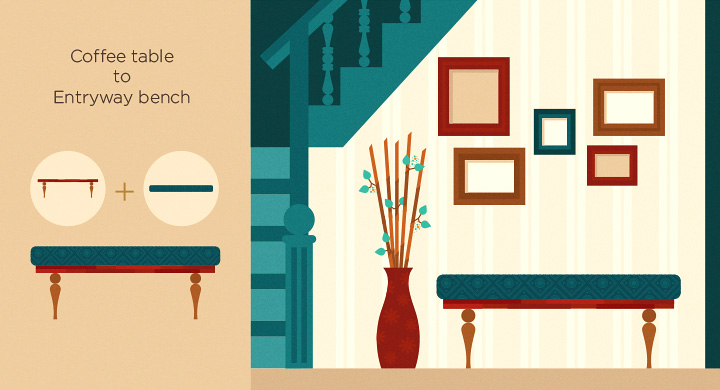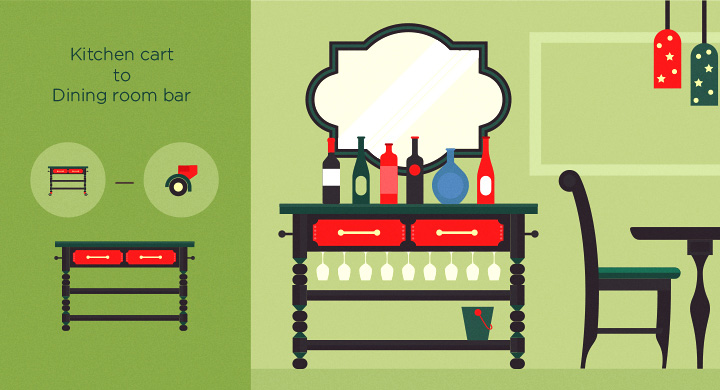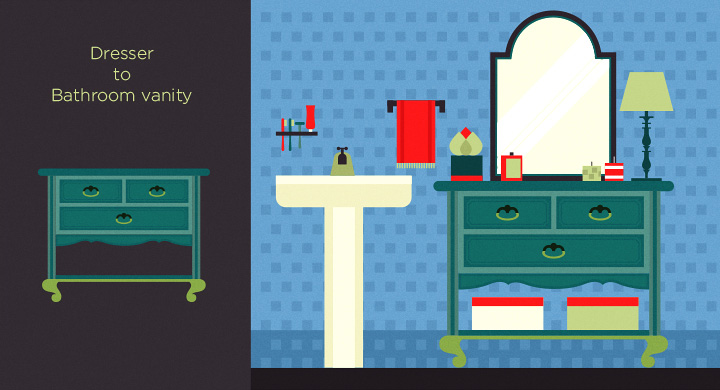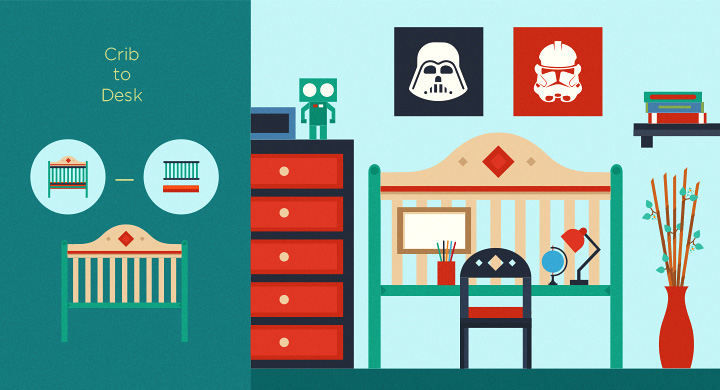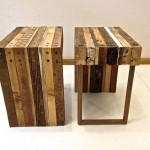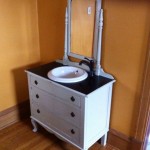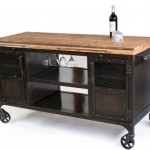Save Space and Kill Two Birds with One Stone
When is a chair not a chair? When it’s a bookshelf, or a table, or a wall panel, or a phone charger! The multifunctional furniture renaissance is here, and it brings seemingly endless ways to reimagine not only furniture’s function, but its form as well.
Multifunctional furniture bolsters the “less is more” attitude of the tiny-house and minimalist movements. Plus with fewer materials, it can also be a sustainable alternative to traditional furnishings. And today’s modern designs have a little something for everyone. Thinking of reimagining your favorite chair? Here are just some of the innovative ideas inspiring us.
Who’s Behind the Multifunction Renaissance?
Furniture that changes shape on a whim to match different needs is a fun conversation starter. But for some people, a piece that pulls double duty is legitimately beneficial, if not necessary to their lifestyles.
Tiny home dwellers are some of the biggest proponents of multifunctional use—not just for furniture, but for every inch of their (on average) 186-square-foot domiciles. When inhabiting a space that pocket-sized, there’s no other option but to buy and build for more than one function. Unlike the houses themselves, the tiny-house market is growing.
The market for tiny apartments, particularly in expensive metro markets such as New York and San Francisco, is also on the rise. With rents booming throughout the Bay Area, even SF’s tech elite are downsizing. In New York, “micro-units” are the newest real estate trend. And as Bloomberg reports, apartments are shrinking throughout the United States. In the case of paying more money for less space, each possession is carefully considered. What value does it bring? What if it had more than just one use?
Finally, worries about the economic rollercoaster and our diminishing natural resources have led many people to adopt a more minimalist lifestyle. By accomplishing more with less, minimalists save money and live more sustainably. Innovations in furniture design play right into these trends and inspire the world to consider: What could we do, if we could do more with less?
Fill the Empty Space: Furniture that Stores Your Stuff
An apartment with a depressing dearth of closet real estate doesn’t signify the end of the world. There are nooks and crannies to be found everywhere—many of them beneath, behind, or even within furniture.
Chairs and sofas, for example, have plenty of space that isn’t used for sitting. Beyond the sleeper-sofas of yesteryear, there are online tutorials for DIY couches and chairs with built in bookshelves.
While reclaiming and upcycling materials, it’s relatively easy to create a table that doubles as a sturdy shelving unit or storage bin. Or create an upcycled bed platform, an under-the-counter cabinet, or a shelf-equipped lamp stand to fit any available space.
With a quick look at a home’s furnishings, its evident there are plenty of extra spaces just waiting to be put to use. Clawfoot tub? Build cabinets to store toiletries around the base. Staircase cutting your hallway in half? Add a custom-built bookshelf, entry table, or even a seating area and shoe rack.
Office Space: Add Function to the Workroom
Multifunction furniture isn’t limited to the home. Double duty furniture is popping up in offices and co-working spaces as well. In this environment, it’s often about transformation: one piece of furniture that serves two or three different functions. To accommodate meetings, employees can install a coffee table that folds out into a loveseat or a side table that scrolls seamlessly into a chair.
Individual work areas offer endless opportunities to customize, allowing each person to create their own ideal workspace with personalized functions. In particular, standing desks provide additional vertical space (compared to a traditional desk), which is great for storage, shelving, and even hiding printers and other less attractive equipment.
In the open office layouts so popular among tech companies and startups, privacy can be a luxury. Consider building your own mini-cubicle atop your desk, which adds storage and cuts down on visual distractions.
For those working from home, carving out space for an office can be a real challenge. Consider a wall-mounted desk that hides away while not in use, or—if you’re feeling more adventurous and don’t mind sleeping on the job—there’s always the desk that transforms into a bed at night.
Live, Work, Eat: Multifunction in the Kitchen
By their very nature, kitchens and dining rooms are extremely functional. But there are a couple of problems. First, many homes now use these areas for much more than food preparation and consumption. The traditional kitchen triangle (sink, stove, fridge) may need to accommodate multiple cooks, not to mention homework zones and hangout areas. Secondly, formal dining rooms have all but disappeared as we return to eating and socializing in the kitchen and living room. The easiest way to update a newly multifunctional space? Multifunctional furniture, of course.
One big way to make the switch is with a kitchen island that also works as a bar or even as a dining table. The bigger the island, the more storage it can contain. To create your own, start with a tall table and add a kitchen-ready surface, plus seating and shelving as needed.
If even table space is a luxury, consider a cabinet that folds out into a table only when you need it. Or take a page from the RVer’s blueprint and design a dinette table that converts to a seating nook when not in use. Kitchen designs are as infinite and unique as your imagination. Start with your space and needs then create from there.
Multi-Fun Zone: Kid-Friendly Furniture Ideas
Just in case all these ingenious concepts weren’t fun enough, try applying the multi-function formula to a kid’s room. In a sense, children’s furniture has more possibilities. For instance, an 8-year-old’s chair may be only 14 inches high, leaving oodles of vertical space for other uses.
Raising a child’s bed off the ground allows for additional storage, seating, or desk space underneath (not to mention that it’ll be a bed they’ll remember forever). An elevated bed also opens the opportunity for extra shelving in the staircase. For a room shared by more than one child, try a Murphy bunk bed or even a sleepover or trundle bed that stores the second mattress in a drawer beneath the first.
Desks can take up a lot of horizontal space (and may not get as much use as you’d like), so consider a folding wall desk, or an easel that converts to a chalkboard or a writing surface. Or add shelving to the desk area so it serves a purpose 24/7.
The real rock stars of modern kids’ furniture are the designs that grow along with your child. Fast-growing kids can burn through clothes, toys, and furniture incredibly quickly, making perfectly good items effectively obsolete in a matter of months. Sustainably designed kids’ products, on the other hand, are created with longevity in mind. As you’re planning your child’s room, don’t just look at what purpose the furniture will serve now: Take the long view, and invest in items that will be useful throughout a child’s lifetime.
When it comes to multifunctional kids’ furniture, it helps to think beyond the first dimension. A baby’s bassinet could one day morph into a study table. A modular design can change its shape to fit your child’s changing needs and preferences. While these grow-along-with-me concepts are becoming easier to find, a custom-built modular furniture set is a smart way for your child to get full use from a room for years to come.
One Room, Many Uses: Multifunction Inspirations for Tiny Spaces
The most captivating multifunctional furniture designs are the most extreme. Though you may never need to pack an entire apartment’s worth of furniture into a single box or fit every possession into 43 square feet, it’s fascinating to see how such tasks have been accomplished by architects and designers worldwide. Most of us have more than one room to work with, but it’s easy to wonder if we’re getting anywhere near as much use out of our available space.
The Murphy bed is a classic example of form and function, but it’s not the only design that can be stored behind a wall panel. Why not a pullout staircase that doubles as a bookshelf, a closet, or a table and chairs? Some of the world’s tiniest apartments effectively hide furniture in the walls, leaving inner space relatively free (so the space itself becomes multifunctional).
If you’ve got high ceilings but limited floor space, remember to play with height. For example, there’s the option to build your bed into the ceiling so it can be lowered at night. Or raise the bed onto a high platform and set up a seating area underneath. For studio dwellers, that frees up valuable floor space for daytime use.
Some of the most extreme designs are little more than cubes that can be stacked or stored in various combinations, making your living space into a pseudo giant Lego set. Would it be annoying to have to continually rearrange your apartment throughout the day? Probably. But for dorm rooms or tiny NYC studios, it may be worth the time and effort.
Multi Task: Technology-Enhanced Furniture
We live in a connected world, and our furniture is starting to catch up. New technology-enhanced furnishings allow buyers to choose whether to show off or hide gadgets, not to mention their pesky cords. And before long, cords themselves may become obsolete, replaced by—you guessed it—power-generating furniture.
Let’s start with the pieces you can create right now, perhaps by repurposing furniture you already own. For example, save counter space by integrating your sound system into a table, bookshelf, or sideboard. Add a laptop docking station, and you’ve got a sound-equipped piece of furniture that charges a computer. Or add a mini-desk and some charge ports to the couch for lazy Internet sessions. Take it a step further by building a laptop keyboard and screen into your coffee table. It only gets better when we consider the possibilities of wireless charging. This technology is available now and already being implemented. It’s possible to create a table, countertop, or any surface that will instantly charge a phone.
The Future is Multifunctional
It may be a while before we attain the midcentury vision of the kitchen that does all the work for us or the bed that changes its own sheets, but that doesn’t mean we can’t ask for more out of our home décor. New convertible and multifunction furniture designs are continually invented, many of which also incorporate sustainable and even reclaimed materials. Nonetheless, it’s entirely possible the perfect item to complete your living space just hasn’t been invented yet. That’s where DIY comes in. How can you reimagine your own furnishings to suit your living space? Progress waits for no man, but without the spark of human creativity, there’d be no progress in the first place.
If this article has you looking for ways to re-use old furniture, check out these recycled wood furniture pieces. — http://www.custommade.com/gallery/barnwood/

